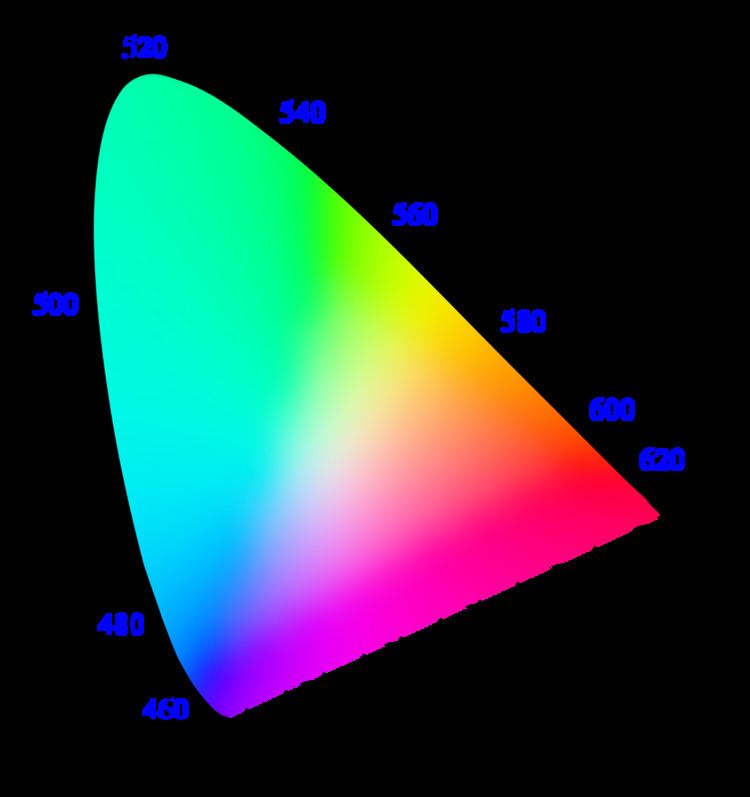 | ||
The Academy Color Encoding System (ACES) is a color image encoding system created by the Academy of Motion Picture Arts and Sciences that allows for a fully encompassing color accurate workflow, with "seamless interchange of high quality motion picture images regardless of source".
Contents
- Background
- System overview
- Color space
- Converting ACES RGB values to CIE XYZ values
- Converting CIE XYZ values to ACES RGB values
- Standards
- References
The system defines its own color primaries that completely encompass the visible spectral locus as defined by the CIE xyY specification. The white point is approximate to the CIE D60 standard illuminant, and ACES compliant files are encoded in 16-bit half-floats, thus allowing ACES OpenEXR files to encode 30 stops of scene information. ACES supports both high dynamic range (HDR) and wide color gamut (WCG).
The version 1.0 release occurred in December 2014, and has been implemented by multiple vendors, and used on multiple motion pictures and television shows. ACES received a Television Academy Emmy Engineering Award in 2012. The system is standardized in part by the Society of Motion Picture and Television Engineers (SMPTE) standards body. Some changes in the ACES specifications change over time, and up to date information is contained at the oscars.org/aces website.
Background
The ACES project began its development in 2004 in collaboration with 50 industry technologists. The project began due to the recent incursion of digital technologies into the motion picture industry. The traditional motion picture workflow had been based on film negatives, and with the digital transition, scanning of negatives and digital camera acquisition. The industry lacked a color management scheme for diverse sources coming from a variety of digital motion picture cameras and film. The ACES system is designed to control the complexity inherent in managing a multitude of file formats, image encoding, metadata transfer, color reproduction, and image interchanges that are present in the current motion picture workflow.
System overview
The system composes of several components which are designed to work together to create a uniform workflow:
Color space
The ACES color space is defined as a set of RGB color primaries that lie just outside of the visible spectrum and completely encompass the CIE spectral locus. The concept of using non-realizable or imaginary primaries is not new, and is often employed with color systems that wish to render a larger portion of the visible spectral locus. The ProPhoto RGB color space developed by Kodak is such system. Values outside the spectral locus are maintained with the assumption that they will later be manipulated through color timing or in other cases of image interchange to eventually lie within the locus. This results in color values not being “clipped” or “crushed” as a result of post-production manipulation.
ACES uses the primaries RGB for the purpose of familiarity in the cinema community, where each primary when varied will respond as expected in a typical RGB additive color system such as sRGB. This is unlike CIE XYZ or CIE xyY where the values do not directly corresponded to an additive primary system, which results in hue shifts if the values are adjusted individually, such as by a colorist. For this reason, CIE XYZ or xyY values are used in purely mathematical ‘connection' spaces and are not directly manipulatable.
ACES RGB values are linear values scaled in an IDT so that a photographic exposure of an 18% grey card would map to a value of 0.18 in OpenEXR. ACES RGB values often exceed 1.00000 for ordinary scenes and a very high range of speculars and highlights can be maintained in the encoding. A neutral color in the ACES color space has equal R, G, and B values, and have a CIE xyY value of x = 0.32168 and y = 0.33767 . These neutral points on the “neutral axis” are derived from an approximation of the CIE D60 Illuminant.
Converting ACES RGB values to CIE XYZ values
Converting CIE XYZ values to ACES RGB values
Standards
ACES is defined by several SMPTE standards which includes:
A SMPTE standard is also under development to allow ACES codestreams to be mapped to the Material Exchange Format (MXF) container.
